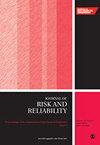Small-sample health indicator construction of rolling bearings with wavelet scattering network: An empirical study from frequency perspective
IF 1.8
4区 工程技术
Q3 ENGINEERING, INDUSTRIAL
Proceedings of the Institution of Mechanical Engineers Part O-Journal of Risk and Reliability
Pub Date : 2024-09-17
DOI:10.1177/1748006x241272827
引用次数: 0
Abstract
As a critical issue of diagnostics and health management (PHM), health indicator (HI) construction aims to describe the degradation process of bearings and can provide essential support of domain knowledge for early fault detection and remaining useful life prediction. In recent years, various deep neural networks, with end-to-end modeling capability, have been successfully applied to the HI construction for rolling bearings. In small-sample environment, however, the degradation features would not be extracted well by deep learning techniques, which may raise insufficient tendency and monotonicity characteristics in the obtained HI sequence. To address this concern, this paper proposes a HI construction method based on wavelet scattering network (WSN) and makes an empirical evaluation from frequency perspective. First, degradation features in different frequency bands are extracted from vibration signals by using WSN to expand the feature space with different scales and orientations. Second, the frequency band with the optimal scale and orientation parameters is selected by calculating the dynamic time wrapping (DTW) distance between the feature sequences of each frequency band and the root mean square (RMS) sequence. With the feature subset from the determined frequency band, the HI sequence can be built by means of principal component analysis (PCA). Experimental results on the IEEE PHM Challenge 2012 bearing dataset show that the proposed method can work well with only a small amount of bearing whole-life data in obtaining the HI sequences with high monotonicity and correlation characteristics. More interestingly, the critical frequency band whose information supports decisively the HI construction can be clarified, raising interpretability in a frequency sense and enhancing the credibility of the obtained HI sequence as well.利用小波散射网络构建滚动轴承的小样本健康指标:频率视角下的实证研究
作为诊断和健康管理(PHM)的一个关键问题,健康指标(HI)的构建旨在描述轴承的退化过程,并为早期故障检测和剩余使用寿命预测提供必要的领域知识支持。近年来,各种具有端到端建模能力的深度神经网络已成功应用于滚动轴承的健康指标构建。然而,在小样本环境下,深度学习技术无法很好地提取退化特征,这可能会导致所获得的 HI 序列缺乏足够的倾向性和单调性特征。针对这一问题,本文提出了一种基于小波散射网络(WSN)的 HI 构建方法,并从频率角度进行了实证评估。首先,利用小波散射网络从振动信号中提取不同频段的退化特征,从而扩展不同尺度和方向的特征空间。其次,通过计算各频段特征序列与均方根序列之间的动态时间包络(DTW)距离,选择具有最佳比例和方向参数的频段。有了确定频段的特征子集,就可以通过主成分分析(PCA)建立 HI 序列。在 IEEE PHM Challenge 2012 轴承数据集上的实验结果表明,建议的方法只需少量的轴承全寿命数据就能很好地获得具有高单调性和相关性特征的 HI 序列。更有趣的是,该方法还能明确其信息对构建 HI 起决定性作用的临界频段,从而提高频率意义上的可解释性,并增强所获 HI 序列的可信度。
本文章由计算机程序翻译,如有差异,请以英文原文为准。
求助全文
约1分钟内获得全文
求助全文
来源期刊

Proceedings of the Institution of Mechanical Engineers Part O-Journal of Risk and Reliability
ENGINEERING, MULTIDISCIPLINARY-ENGINEERING, INDUSTRIAL
CiteScore
4.50
自引率
19.00%
发文量
81
审稿时长
6-12 weeks
期刊介绍:
The Journal of Risk and Reliability is for researchers and practitioners who are involved in the field of risk analysis and reliability engineering. The remit of the Journal covers concepts, theories, principles, approaches, methods and models for the proper understanding, assessment, characterisation and management of the risk and reliability of engineering systems. The journal welcomes papers which are based on mathematical and probabilistic analysis, simulation and/or optimisation, as well as works highlighting conceptual and managerial issues. Papers that provide perspectives on current practices and methods, and how to improve these, are also welcome
 求助内容:
求助内容: 应助结果提醒方式:
应助结果提醒方式:


